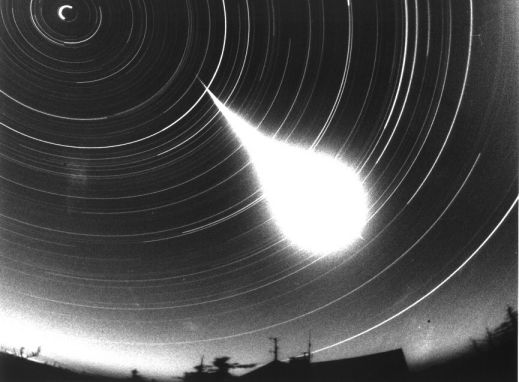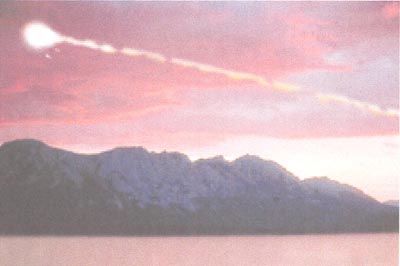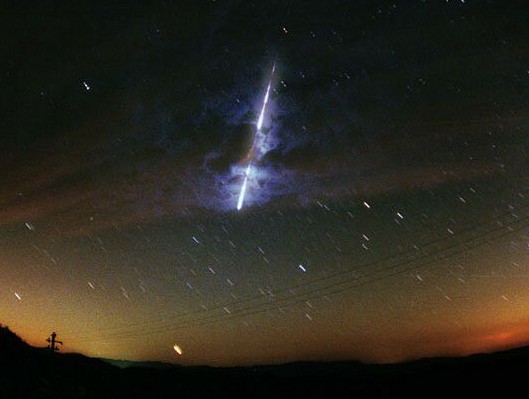meteor fireball caused Auckland blaze


The fire at Ponsonby's Olympic Commercial Laundry building on Saturday night was thought to be accidental. Photo / Dean Purcell
I saw the meteorite from the top of Mount Eden and I have a BSc in Geology so have a good understanding of what I saw. The blinding green flash was the meteorite entering our atmosphere, it didn’t seem to break the sound barrier as it entered. It looked like it was burning out and left a vapor trail that hung for about five minutes. It was going very fast and would have been burning at about 2,000 degrees, the same as basaltic magma. To clarify, a meteorite is smaller than a metre in diameter and they are not that rare. The meteorite was travelling towards the Ponsonby area and I am not at all suprised that it caused a building to ignite. - Melissa

Laundry owner Dave Hurt's desire to get an early start on van loads of dirty linen from Auckland's restaurants nearly cost him his life on Saturday night.
Mr Hurt, 66, was sleeping in the office above his Olympic Commercial Laundry in Grey Lynn when he was woken by smoke.

"I went downstairs to the front door which was deadlocked," he said.
"I realised then the trousers I pulled on didn't have the keys in the pockets - and I couldn't go back up there.

"Luckily, a fireman arrived at the door and let me out.
"It was all smoke and the place was well ablaze within half an hour."

The fire about 10.30pm quickly gutted the concrete building, though efforts to stop it spreading to adjacent buildings were successful.

Looking at the collapsed, burned roof of his MacKelvie St building of 35 years, Mr Hurt said the fire came at the busiest time of year for the laundry and linen hire business, which serves 150 restaurants.
"We are flat out. I was going to light the boiler and get a few loads done before the staff come in at 5am."
A warehouse in Auckland, New Zealand was destroyed by fire after what witnesses claim was a direct meteorite hit.
According to the NZ Herald:
Some people were convinced the fire was caused by what may have been a meteorite, which was seen from various parts of the upper North Island streaking across the sky just after 10 o';clock.
Several callers claim the light in the sky was very bright, and it was described by some as a blinding flash. Others said it was trailing smoke.
One man, Mike, says he saw the object crash with an exploding noise in the Ponsonby area, and reckons it could have started the fire.

There are three kinds of meteorites, stony, iron, and stony-iron. Stony meteorites consist of minerals rich in silicon and oxygen, with smaller amounts of iron, magnesium, and other elements. One group of stony meteorites, called chondrites, are pieces of the same material from which the planets formed. Another group of stony meteorites, the achondrites, were once part of a parent body, such as an asteroid, that was large enough to have melted and separated into an iron-rich core and a stony crust. Achondrites come from the outer crust; stony-iron meteorites, from the inner crust; and iron meteorites, from the metallic core. Iron meteorites consist mostly of iron and nickel. Stony-iron meteorites have nearly equal amounts of silicon-based stone and iron-nickel metal.

The size of meteorites varies greatly. Most of them are relatively small. The largest meteorite ever found weighs about 66 short tons (60 metric tons). It fell at Hoba West, a farm near Grootfontein, Namibia. However, much larger bodies, such as asteroids and comets, can also strike the earth and become meteorites.
Meteorites reach the earth's surface because they are the right size to travel through the atmosphere. If they are too small, they will disintegrate in the atmosphere. If they are too large, they may explode before reaching the earth's surface. One such object exploded about 6 miles (10 kilometers) above the Tunguska River in Siberia in 1908, leaving a 20-mile (32-kilometer) area of felled and scorched trees.
Thousands of small meteorites have been found in Antarctica, providing a rich supply of specimens for scientists to study. Scientists study meteorites for clues to the types of material that formed the planets.

We were having a late dinner in a restaurant (23 Princess Wharf) when I have seen a flash illuminating the sky back to me. When I turn back, I have seen the huge tail of the meteorite up to my head. The tail desappeared a little bit like a firework does, in about 2 seconds. I use to practice skydiving and I can tell you it was under 500m. It was flying from W-NW to E-SE and passed up to the Harbour Bridge. If the warehouse fire at Ponsonby was caused by it, it wasn’t the main part of the meteorite but it could be from a piece of it.
Because The Geminids (meteor shower) were currently at their peak level of activity on the 13/14 of December 2008,

We were having a bbq in Morningside and the Meteorite went straight over our heads and lit up the whole sky with bit trail flash lasting for about 6-7 seconds. It was definitely heading towards the Ponsonby area
I did see the meteor and I must say it was impressive and a privilege to witness.
I happened to be outside in the countryside south of Auckland chatting with some freinds after a family BBQ and about 7 of us bore witness to it tearing over directly above us towards the glow of Auckland city, one amongst us is a very keen amateur astrologer but he was unfortunately the only one inside at the time and very disappointed to have missed it.

The flash of light it produced lit up everything like a bright lighting strike, it was traveling extremely fast for an object which has made it through to the inner atmosphere with the flash from the burn lasting no longer than a decent lightning strike.
The trail went right across the sky and though it’s very difficult to distinguish distance in the sky, especially at night it was however low enough to clearly make out the turbulence patterns inside the vapour trail as it was clearly illuminated by the near full moon and the width of the trail was a lot wider than is seen behind passenger jets, either meaning it was lower or was simply a lot bigger. (we speculated whether it was gas ionisation that caused the glow or moonlight and didn’t really come to a conclusion.)
It did hang around for about 5 mins and then just dispersed evenly before disappearing.
We didn’t hear anything, waited for a sonic boom but heard nothing.
It was definitely heading in the direction of the city.

leonid lorenzo
A large group of us were at a party in Mount Eden North, and quite a few people saw the event… although it was so quick/brief that there was much debate about what it was we all saw. The flash itself was like a massive lightning strike. No identifiable sound. I managed to look up and see a burning almost white object streak out of the sky. Hard to judge the size, but about equal to 1/25 the size of the full moon - and shaped like a slightly flattened jellybean. It was a decent sized piece of rock. It was travelling so fast (like a bullet) that it was litterally gone in a fraction on a second (hence i would be surprised if anyone had time to film it - unless there was a camera already fixed on that section of sky filming).
I say “out of the sky” not “across the sky” because what struck me instantly was the angle of entry. The vapour trail was very clear, slightly illuminated (possibly by the moon) and left hanging until it dissipated after about 10 seconds. From where i stood the thing seemed to come almost directly from the upper atmosphere on a 75% trajectory (if 90% were vertical) and i had the sensation that it was very close to us… possibly under 1500m and heading basically NNE towards the sky tower area (although i had the feeling it was gonna hit around Bond St area). Intense.


Metaor strike at sunset

Meteor smoke trail
The brightest meteor, a fireball, leaves a smokey persistent trail!
A meteoroid is a small sand- to boulder-sized particle of debris in the Solar System. The visible path of a meteoroid that enters Earth's (or another body's) atmosphere is called a meteor, or commonly a "shooting star" or "falling star". If a meteoroid reaches the ground, it is then called a meteorite. Many meteors are part of a meteor shower. The root word meteor comes from the Greek meteōros, meaning high in the air.

If the object is larger than a meteoroid, it is called an asteroid; smaller than that, it is interplanetary dust. The current official definition of a meteoroid from the International Astronomical Union is "a solid object moving in interplanetary space, of a size considerably smaller than an asteroid and considerably larger than an atom."[1] The Royal Astronomical Society has proposed a new definition where a meteoroid is between 100 µm and 10 m across.[2] The NEO definition includes larger objects, up to 50 m in diameter, in this category.

The composition of meteoroids can be determined as they pass through Earth's atmosphere from their trajectory and the light spectra of the resulting meteor. Their effects on radio signals also yield information, especially useful for daytime meteors which are otherwise very difficult to observe. From these trajectory measurements, meteoroids have been found to have many different orbits, some clustering in streams (see Meteor showers) often associated with a parent comet, others apparently sporadic. The light spectra, combined with trajectory and light curve measurements, have yielded various compositions and densities, ranging from fragile snowball-like objects with density about a quarter that of ice,[3] to nickel-iron rich dense rocks. A relatively small percentage of meteoroids hit the Earth's atmosphere and then pass out again: these are termed Earth-grazing fireballs.

A meteor typically occurs in the mesosphere, and most visible meteors range in altitude from 75km to 100km.

(there is a super-8 film of this event, I have seen it on TV)
For bodies with a size scale larger than the atmospheric mean free path (10 cm to several metres) the visibility is due to the heat produced by the ram pressure (not friction, as is commonly assumed) of atmospheric entry. Since the majority of meteors are from small sand-grain size meteoroid bodies, most visible signatures are caused by electron relaxation following the individual collisions between vaporized meteor atoms and atmospheric constituents. The meteor is simply the visible event rather than an object itself.
 Stumble It!
Stumble It!
0 Comments:
Post a Comment
<< Home